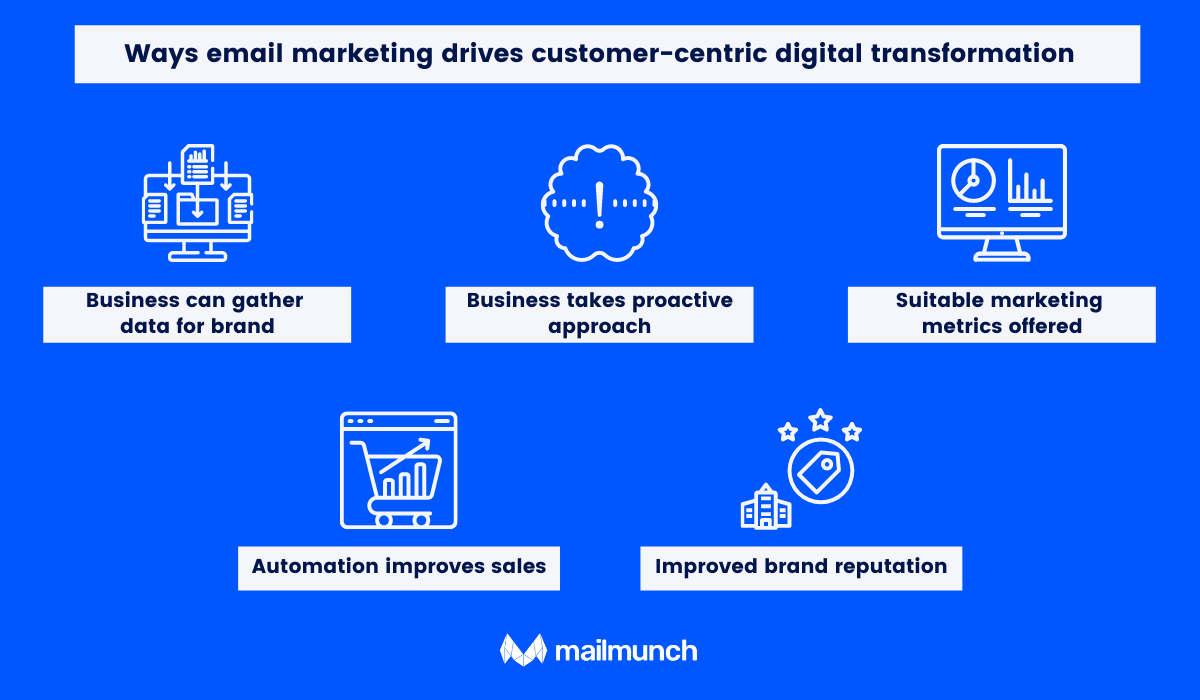

Last updated on
February 8, 2024
Digital transformation isn't just about adopting innovative technologies. At heart, it is about customers as they are the primary catalyst driving the digital disruption. Hence, brands need to focus on a customer-centric approach to strengthen loyalty and advocate digital transformation strategies.
A customer-centric digital transformation prioritizes a seamless customer experience. It integrates innovative technologies in all business areas, changing how businesses operate and deliver value to customers.
It also triggers cultural change, requiring organizations to plan and implement change management strategies.
Email is one of the amazing channels that can deliver an excellent experience.
Therefore, email marketing allows brands to provide relevant and personalized experiences during each buyer journey stage, allowing them to understand how a product or service can support their lifestyle.
Further, being data-centric, email marketing encourages brands to create a collaborative team that delivers connected experiences through various channels.
This post will share how email marketing is a crucial component of a digital strategy and help brands achieve customer-centricity.
Each marketing tactic is unique in terms of digital transformation. For instance, most business strategies invest in content marketing, email marketing, social media marketing, organic or paid search, digital advertising, and online events to boost brand awareness and generate leads.

However, email marketing stands out as the winner because email offers an unbeatable ROI compared to any other channel.
Research shows that email marketing generates $42 for every $1 spent. In other words, email marketing generates an astounding ROI of 4200%, thus making it the most effective marketing channel available today.
Further, email marketing ties all your marketing efforts together and has a longer lifespan than your social posts.
For instance, tweets have a short lifespan of about 18 minutes. Within half an hour, they seem to disappear into the abyss of Twitter's newsfeed.
On the other hand, email placement in the recipient's inbox is more prominent. It is easy to reference the email later.
Also, emails offer a way to send personalized messages to prospects and customers.

Advances in email automation and the data-centric nature of email marketing have made it possible for marketers to send tailored messages based on subscriber preferences. This kind of marketing is perfect for attracting leads, delighting existing customers, and delivering connected experiences.
In fact, according to Litmus' State of Email Survey findings, brands that personalize their email content see an ROI of 44:1 compared to 36:1 for brands that don't.
Finally, post-purchase emails allow marketers to reinforce their brand value, thus forming a deeper connection with their audience and building a better reputation.
Therefore, email marketing can drive customer-centric digital transformation because it focuses on delivering extraordinary brand experiences that revolve around a 360-view of the customer. The digital transformation process persuades marketers to invest in technology to decipher and create meaningful customer experiences.
For instance, many of Heathrow's popularity and success comes from its investment in technologies that make flying to and from the airport more enjoyable for travelers and airlines. They have invested in several digital initiatives that aim at connecting with passengers, one of which is email.
Heathrow's customers receive email newsletters as a part of their loyalty program. They also leverage Adobe Campaign to deliver targeted emails that pique customer interest and keep them returning.

We know why email marketing is key to driving digital transformation. Let's see how this marketing channel can propel customer-centric digital transformation.
Email marketing is pretty data-centric.
It enables brands to collect behavioral, location-based, and real-time demographic data. The insights derived from this data allow marketers to create meaningful experiences and ensure hyper-personalization.
Thus, brands can go beyond merely monitoring buyer preferences to interpreting and devising strategies based on real-time customer data.
Going back to the Heathrow example we shared earlier; the airport brand uses hyper-personalization to distribute 130 targeted emails each month. It delivers suitable promotional offers to customers, thus boosting their click-through rates and open rates by 25%.
The massive amount of data collected through emails are processed using automation systems. It helps marketers identify what customers are looking for, need, or buy next. Such predictive automation enables brands to offer elevated experiences.
Thus, automated email marketing can help businesses provide what they have promised to their customers for their loyalty and subscription to their brand.
Whether it's a thank-you email or a reminder to shop, automation email marketing is a great tactic to stay connected with and engage customers in this age of digital transformation.
A Salesforce survey of 7,000 senior marketers leading through change revealed that 69% of marketers expect businesses to offer connected experiences. They want to move seamlessly to new channels to make their buying decisions.
Customer data gathered through emails allows marketers to offer automated solutions like chatbots that help them learn more about human behavior and interactions.
Thus, businesses can use emails to drive customer-centric digital transformation by combining human interactions and AI technologies.
Conversational AI allows businesses to understand what customers ask or respond to a promotion.
This data, along with a customer's historical information, helps marketers gain insights into how to help customers better. If there's unusual behavior, the technology enables them to solve the issue proactively, thus adding to customer delight.
Email remains the most popular and preferred marketing channel with customers. Nearly half of the customers prefer emails over other channels like SMS and push messages from brands.
So, to embrace agility, marketers should consistently track emails. Monitoring metrics like click-throughs and open rates can help businesses determine whether their emails engage relevant customers.
For instance, a lower open rate shows that your email's subject line isn't effective or valuable enough to trigger an action. Similarly, a higher unsubscribe rate means your marketing team needs to revise the email content and make it more engaging.
This Natera case study shows how the Texan clinical genetic testing company increased its email engagement using Seventh Sense and HubSpot tools. These tools enabled them to use send-time optimization to discover the best time to connect with subscribers.
Natera noticed that engaged recipients were 2.5% more likely to open emails and nearly 24% more likely to click through their content. Natera saw an 85% rise in new contacts from email marketing within the first half of the year by increasing their open and click-through rates.
Data and analytics are the fuel for any digital transformation activity today. Leverage analytics and track the relevant email metrics to see how your emails perform. Identify areas to improve customer engagement and relationships via email.
Define your buyer persona through the insights derived from analytics to boost your email strategy's chances of success.
Marketing tactics shouldn't just target and promote products and services. It should recognize loyal customers and reward them with discounts, coupons, personalized emails, and other promotional offers.
While prioritizing customer-centricity in digital transformation, businesses need to pair email strategies with emails attesting to brand authenticity.
In other words, the email campaign should comprise emails that show how much the business cares about its relationship with its subscribers.
So, to build successful relationships, brands can leverage technology to reward customers on their birthdays, anniversaries, or other special occasions.
AI offers an innovative way for businesses to improve personalization, creation, and delivery. The technology pushes the boundaries of email marketing automation to help businesses offer enhanced experiences to their customers.
Implementing advanced technology in their email strategies gives brands a competitive edge and boosts their reputation. Instead of differentiating themselves on price, product quality, or customer experience, email marketing automation allows them to distinguish on purpose.
Such email strategies are usable to spearhead customer-centric digital transformation.
Transparency about the process helps businesses build trust and loyalty.
Take time to monitor your emails. Analyze whether these emails appeal to customers or are consistent with your brand's voice and persona.
The growing and changing customer expectations and technological advances are the primary drivers of a brand's digital transformation strategy. These technologies are enabling brands to offer hyper customer-centric experiences.
In such a disruptive scenario, emails marketing can be the best channel marketers can leverage in such a disruptive scenario.
Emails have always been a critical part of a business's digital strategies because firms have realized their valuable contribution to creating holistic and powerful strategies. They help marketers to achieve customer-centricity using customer data for creating personalized messages.
Additionally, email marketing will continue to bridge the gap between digital transformation and customer experience as we advance. The marketing channel will give brand owners the agility to improve their customer experience through their enterprise.
Music lover by passion and Head of Marketing by career, Hasan is all about catering marketing, branding, advertising and content teams together, helping them meet company goals. With his decade worth of experience, he has worked for global enterprises and early-stage companies in multiple industries and developed innovative demand generation and account-based marketing (ABM) strategies and programs that achieved key business goals and revenue growth.
Tags:

M. Usama
April 19, 2024

M. Usama
April 19, 2024

M. Usama
April 18, 2024